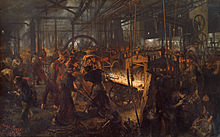United King's and Laura's Hut
The United Königs- and Laurahütte was a stock company founded in 1871 for mining and smelting. Your company headquarters was Berlin , the main field of activity was Upper Silesia . The company was one of the largest German companies during the German Empire . It was an amalgamation of important older companies. These included the Königshütte (1797) and Laurahütte (1838).
Origin company
The Königshütte dates back to 1797 and was initially owned by the state. It was there that one of the first smelting works operated with steam power on the European continent was built. A blast furnace pierced in 1802 was the largest in Europe at the time. The company expanded further in the 1850s.
The Laurahütte was a steelworks established in the 1830s by the magnates Hugo Henckel von Donnersmarck near Beuthen . The first integrated ironworks in Upper Silesia was built there in 1838. In its time, it was one of the largest ironworks. Its demand has greatly boosted coal mining in the region.
The Königshütte gave its name to the town of the same name (today Chorzów ) and the Laurahütte gave the place of the same name (Polish Huta Laura , today part of Siemianowice Śląskie , German Siemianowitz-Laurahütte ) its name.
United companies
In 1864 Karl Richter , who had previously been director of the Königshütte, was made head of the Laurahütte by Count Hugo Henckel von Donnersmarck . Richter had successfully managed the hut through the following crisis years. On Richter's advice, Hugo Henckel von Donnersmarck also bought the then technically obsolete Königshütte in 1869. Richter became director of the Königshütte and successfully renovated it. It was also he who suggested to the count that the two companies be merged and that a joint-stock company be created.
In 1871 Henckel von Donnersmark brought both companies into the new "United Königs- und Laurahütte Aktiengesellschaft für Bergbau und Metallgesellschaft". Richter was director general from 1871 to 1893.
During this time the company succeeded in making it one of the most important mining industrial groups in Germany. The shares of the United Königs- and Laurahütte were among the safest German investment papers and the company's balance sheets were an important yardstick for economic development in Germany.
In 1875 , Adolph von Menzel undertook a study trip to Königshütte for the famous painting “Eisenwalzwerk” .
Corporate structure
The property included the Königshütte, the Laurahütte, several coal and ore mines or pits. As a result, the company expanded strongly through acquisitions. The Königshütte iron and steel works comprised seven blast furnaces, a puddling works, iron and steel foundry, Bessemer pear , works for Martin and Thomasstahl and rolling mills . Their products were processed in the company into bandages, wheels or switches. In addition, there was the Laurahütte with four blast furnaces and other associated parts of the factory, the Eintrachtshütte and the Katharinenhütte, each with further processing operations. In Russia, the company had leased further smelters. In addition, the company still owned four manors.
Hard coal production alone amounted to 2.4 million tons in 1904. At home and abroad it extracted 79,000 tons of ore. In 1903/04, the smelting works produced 220,841 tons of pig iron. In addition, there were 14.852 tons of cast goods, 208,000 tons of rolled iron and other products. The gross cash receipts were 52.66 million marks, the gross profit at 7,070,514 marks. The average dividend from 1871 to 1904 was 8.1%.
In 1904 the company had a total of around 21,000 employees.
After the First World War
After the loss of the First World War , most parts of the company were located in Poland , despite a clear German majority . Since 1925/26 they have been continued there by Górnośląskie Zjednoczone Huty Królewska i Laura SA as a stock corporation under Polish law. The German stock corporation still had some mines and mining rights. The company was liquidated in 1936. Friedrich Flick showed interest in the Polish possessions as early as the 1920s and acquired considerable shares there.
In 1944, a branch of the Auschwitz concentration camp was established on the site of the Laurahütte . A forced labor camp had existed there since 1941.
After the Second World War
After the Second World War , all German companies were expropriated by the Polish state without compensation ( Bierut decrees ). The expropriated companies were transferred to Polish state property and divided into industrial combines according to the Soviet model. The heavy industrial tradition in Siemianowice Śląskie and Chorzów was continued until 1990 under the conditions of the communist planned economy .
Individual evidence
- ↑ on developments in the Richter era see: Konrad Fuchs: Richter, Karl. In: New German Biography (NDB). Volume 21, Duncker & Humblot, Berlin 2003, ISBN 3-428-11202-4 , p. 533 f. ( Digitized version ).
- ↑ Entry on germanhistory.doc
- ↑ The Place of Terror. History of the National Socialist Concentration Camps Volume 5: Hinzert, Auschwitz, Neuengamme. Munich 2007, p. 270ff.
literature
- Toni Pierenkemper: The industrialization of European mining regions in the 19th century. Stuttgart 2002.
- Klemens Skibicki: Industry in the Upper Silesian Principality of Pless in the 18th and 19th centuries. Stuttgart 2002, ISBN 978-3-515-08036-1 .
- Wilhelm Treue: Economic and technical history of Prussia. Berlin 1984.



